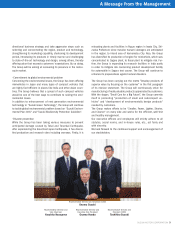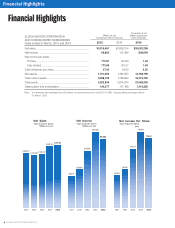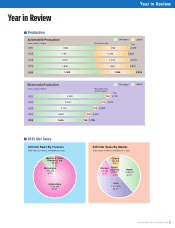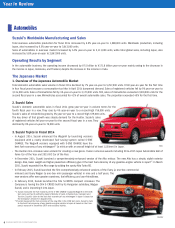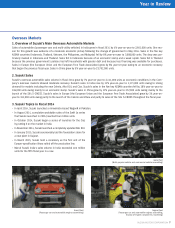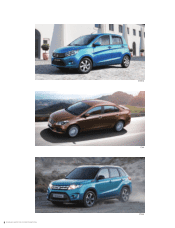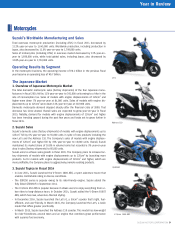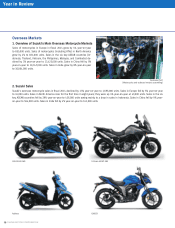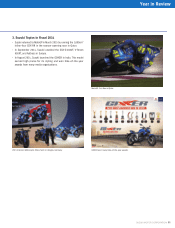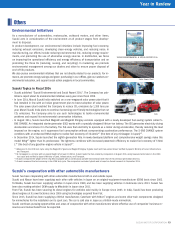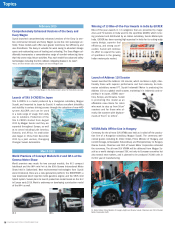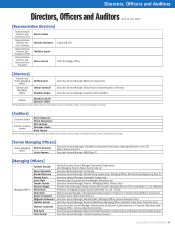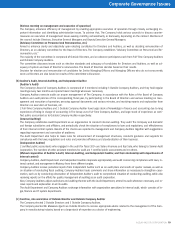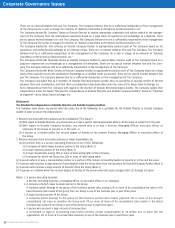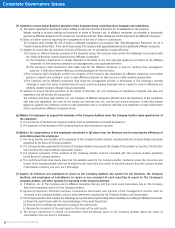Suzuki 2015 Annual Report Download - page 15
Download and view the complete annual report
Please find page 15 of the 2015 Suzuki annual report below. You can navigate through the pages in the report by either clicking on the pages listed below, or by using the keyword search tool below to find specific information within the annual report.
SUZUKI MOTOR CORPORATION 13
Year in Review
Others
Lithium-ion Battery ISG
Solar Power Plant
SUZUKI ENVIRONMENTAL & SOCIAL REPORT 2014
AltoWagonR
Environmental Initiatives
As a manufacturer of automobiles, motorcycles, outboard motors, and other items,
Suzuki acts in consideration of the environment at all product stages from develop-
ment to disposal.
In product development, our environmental initiatives include improving fuel economy,
reducing exhaust emissions, developing clean-energy vehicles, and reducing noise. In
manufacturing, our eorts include reducing environmental risk, reducing energy require-
ments, and promoting the use of alternative energy sources. In distribution, we focus
on improving the operational eciency and energy eciency of transportation and on
promoting the three Rs (reducing, reusing, and recycling). In marketing, we promote
environmental management among our dealers and strive to ensure proper disposal of
end-of-life products.
We also pursue environmental initiatives that are not directly related to our products. For in-
stance, we promote energy savings and green purchasing in our oces, give our workers en-
vironmental education, and support social action programs in local communities.
Suzuki Topics in Fiscal 2014
• Suzuki published “Suzuki Environmental and Social Report 2014”. The Company has pub-
lished a report about its environmental initiatives every year since scal 1999.
• In June 2014, Maruti Suzuki India switched on a one-megawatt solar power plant that it
had installed in line with an Indian government plan to boost adoption of solar power.
The solar power plant enabled the Company to reduce CO2 emissions by 1,200 tons per
year. Maruti Suzuki India plans to continue harnessing eco-friendly technologies that cut
CO2 emissions. The Company aims to use such technologies to tackle environmental
problems and expand its environmental conservation initiatives.
• In August 2014, Suzuki launched WagonR and WagonR Stingray versions equipped with a newly developed fuel-saving system called S-
ENE CHARGE. An integrated starter generator (ISG) works with a specially designed lithium-ion battery. The ISG generates electricity during
deceleration and stores it in the battery. The ISG uses that electricity to operate as a motor during acceleration, thereby reducing the load
imposed on the engine, so it suppresses fuel consumption without compromising acceleration performance. The S-ENE CHARGE system
combines with an enhanced R06A engine to realize fuel economy of 32.4km/L*1 (the best of any miniwagon in Japan)*2.
• In December 2014, Suzuki launched the eighth-generation Alto. A newly developed platform and comprehensive weight savings make this
model 60kg*3 lighter than its predecessor. The lightness combines with increased powertrain eciency to realize fuel economy of 37km/
L*4 (the best of any gasoline-engine vehicle in Japan)*4.
*1 Measured in the JC08 test cycle using the WagonR FZ grade and WagonR Stingray X grade (each with two-wheel drive). Veried by Japan’s Ministry of Land, Infrastructure,
and Transport.
*2 A miniwagon is a minicar with an overall height of at least 1,550mm. Suzuki made the fuel-economy comparison in August 2014 using measurements taken in the JC08
test cycle and veried by Japan’s Ministry of Land, Infrastructure, and Transport.
*3 Suzuki compared the weight of the new Alto (equipped with a continuously variable transmission) with that of the previous-generation Alto Eco.
*4 Suzuki measured the fuel economy in the JC08 test cycle. The comparison excludes hybrids and is based on Suzuki research in December 2014.
Suzuki’s cooperation with other automobile manufacturers
Suzuki has been cooperating with other automobile manufacturers both in and outside Japan.
Suzuki and Nissan have been supplying each other with vehicles in Japan on an original-equipment-manufacturer (OEM) basis since 2002.
To Mazda, Suzuki has been supplying vehicles in Japan since 1989, and has been supplying vehicles in Indonesia since 2013. Suzuki has
been also making vehicles’ OEM supply to Mitsubishi in Japan since 2011.
From Fiat, Suzuki has been sourcing its diesel engines for vehicles sold mainly in Europe since 2003. In India, Suzuki has been producing
diesel engines at its own factories since 2006 using technologies acquired from Fiat.
Since 2013, Suzuki has been supplying a British manufacturer, Caterham with 660
cm
3
engines and some drive-train components designed
for minivehicles for the installation on its sport cars. The car is sold also in Japan as a British-made minivehicle.
Suzuki continues pursuing opportunities and areas of cooperation with other manufacturers where eective use of companies’ business re-
sources and mutual benet can be expected.


